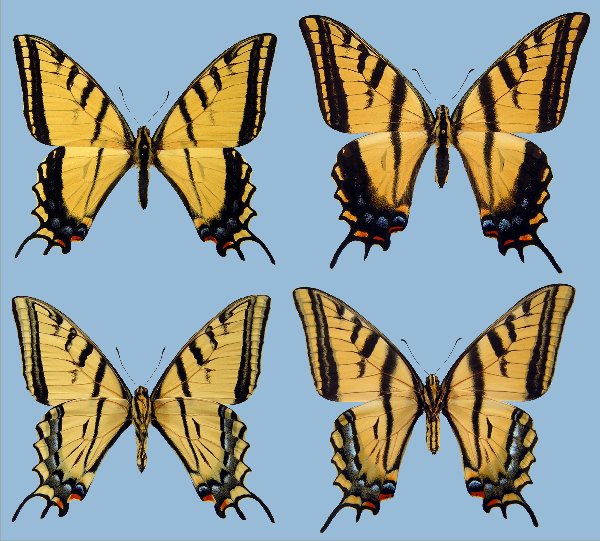Papilio multicaudata pusillus

Photo Life History: Papilio multicaudata pusillus
Habitat: Mountain Canyons; Valley Lakes & Rivers; Urban-Suburban;
Host Plants: Prunus virginiana; Fraxinus pennsylvanica.
Suitable Lab Host Plants:
Caring for Live Female Butterflies: Feed females every day.
Methods of Female Oviposition: The open screen cages slide show demonstrates how this is accomplished for glaucus-group females, which, can be quite uncooperative for a few days when it comes to laying eggs in captivity. It's important to set them up in a cage where there is plenty of room to fly to and from the host plant. Also, provide nectar sources for females. Clark Thompson created a successful setup for California populations of Papilio rutulus.
How to Find Eggs: Look for immatures on isolated host plants, if at all possible.
How to Hatch Eggs: Consolidate eggs into one container.
How to Find Caterpillars in the Field: For earlier instars, look on the dorsal side of the leaf. For later instars, look for swallowtail pads. Finding glaucus-group caterpillars in numbers can be difficult and sometimes requires a certain degree of patience and hard work. Always remember to look for isolated host plants. Another helpful hint to find caterpillars applies especially to the state of Wyoming where cities such as Evanston, Green River, Rock Springs, and Rawlins have planted green ash in their corporate areas. In past years, two-tailed swallowtails have utilized these trees and larvae have been found on them in fairly good numbers.
If looking on the "Canada Red" variety of Prunus virginiana, from May through July, focus on the new growth green leaves before they turn burgundy, where eggs and larvae are more conspicuous. Also, in August, large green fifth instar caterpillars make an amazing contrast against the older burgundy leaves.
Caterpillar setups: Open terrariums; Open Bucket.
Larva to Pupa: Larva purges and wanders; Larva Changes Color.
Number of Broods per Year: 1
Overwintering Stage: Pupa.
Overwintering Strategies: Your Own Backyard; Refrigerator
Post-Hibernation Strategies: Expose pupae to room temperature, long-day photoperiod and high humidity (mist spray them daily.)
Avoiding Diapause Techniques: Not applicable.
Disease Prevention: Change out host plant and remove frass every five to six days using the open terrarium technique.
Emergence: Emergence Container
Field Notes:

